Yermo, California
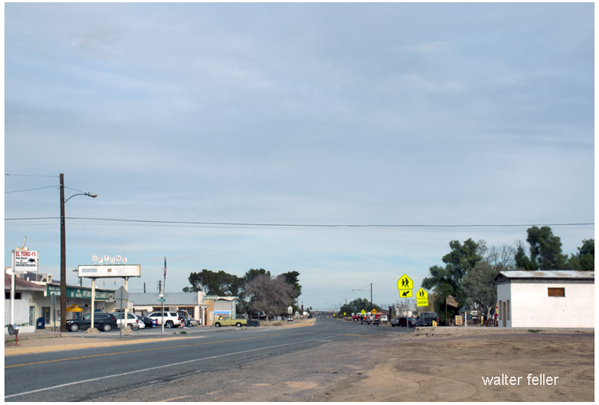
Yermo, California, is a small unincorporated community located in the Mojave Desert, within San Bernardino County. Its history reflects many of the broader trends in the development of the American West, particularly the influence of transportation routes and the exploitation of natural resources.
Early History and Development
Originally, the area around Yermo was inhabited by Native American tribes such as the Vanyume (a subgroup of the Serrano), who lived along the Mojave River and in regions across the Mojave Desert. The arrival of Spanish and later Mexican explorers and settlers introduced new dynamics to the region, although Yermo itself did not develop significantly during these periods.Arrival of the Railroads
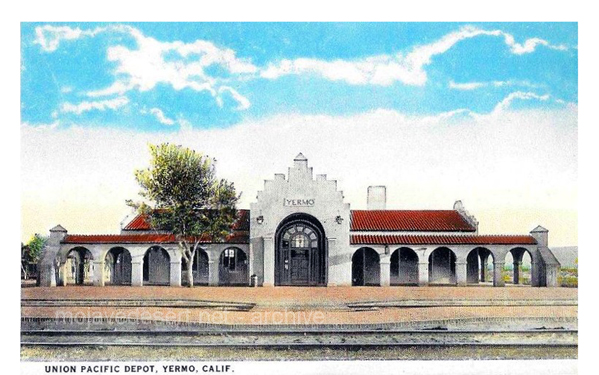
Yermo’s history as a community begins more distinctly with the expansion of railroads in the late 19th and early 20th centuries. It became an important railway junction. The presence of the railroad made it a strategic location for the transportation of goods and mining outputs, including borax, which was extensively mined in the nearby area, notably around Boron and Death Valley.
Mid-20th Century Growth
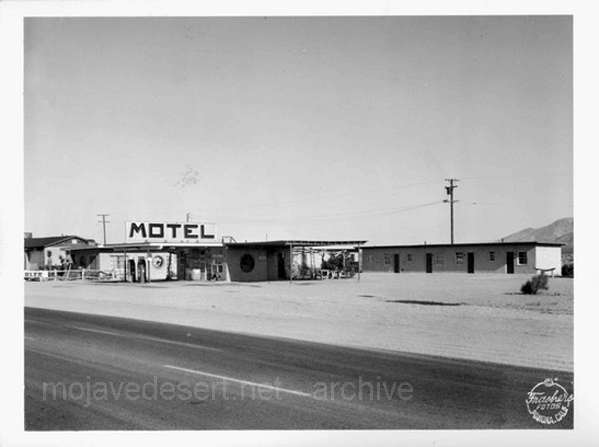
During the mid-20th century, Yermo served as a support site for the military, particularly during World War II. Its proximity to military bases such as the Marine Corps Logistics Base Barstow increased its strategic importance. The establishment of these military facilities provided a significant boost to the local economy and population.
Tourist Attractions and Economy
Yermo is also known for tourist attractions that capitalize on the history and natural environment of the Mojave Desert. Calico Ghost Town, a former mining town that has been converted into a county park, is located nearby. It offers visitors a glimpse into the mining era of the late 19th century, which was crucial to the development of many small desert communities.Modern Yermo
Today, Yermo remains a small community with a population of a few thousand. Its economy is supported by the presence of the nearby military installations, tourism related to its historical sites and natural beauty, and its role as a commercial hub along the Interstate 15 corridor, which is a major route between Southern California and Las Vegas.Yermo exemplifies many characteristics of small desert towns in the American West, particularly those shaped by the twin forces of transportation and natural resource exploitation.
Founded in 1902 and originally named Otis, and renamed Yermo, a name derived from a Spanish word for "wilderness."
Yermo: A community 4.5 miles northeast of Daggett. When the San Pedro, Los Angeles, and Salt Lake Railroad was built through there in 1902 the station was named Otis for General Harrison Gray Otis, a Civil War veteran and the second publisher for the Los Angeles Times. The name was changed to Yermo when the post office was established on 21 October 1905. In 1905 the railroad and the roundhouse and depot were completed. In 1980 the population was 1,092. This is the Union Pacific Railroad's principal operating point between Victorville and Las Vegas.
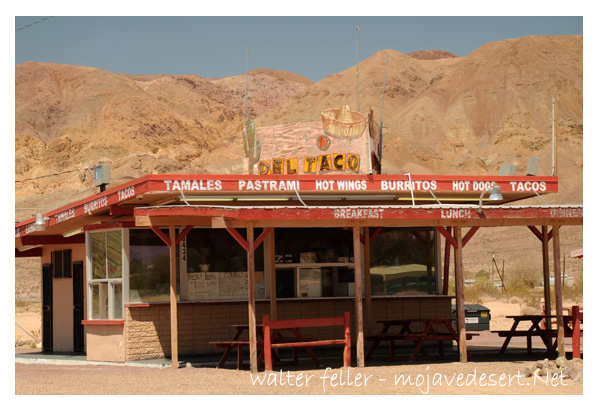
Del Taco in the 1960's - A Brave New Venture
"Ed Hackbarth and David Jameson opened the first Del Taco in Yermo, CA in 1964. With a menu of 19˘ tacos, tostadas, fries and 24˘ cheeseburgers, Del Taco brought in $169 in sales on its first day in business - the equivalent of 900 tacos. Things were off to a bold start."
from - Official History of Del Taco
Peggy Sue's is an original roadside Diner, built in 1954 with 9 counter stools and 3 booths. It sets in on the shadow of the Calico Mountains and was built from railroad ties and mortar from the nearby Union Pacific Rail yard.
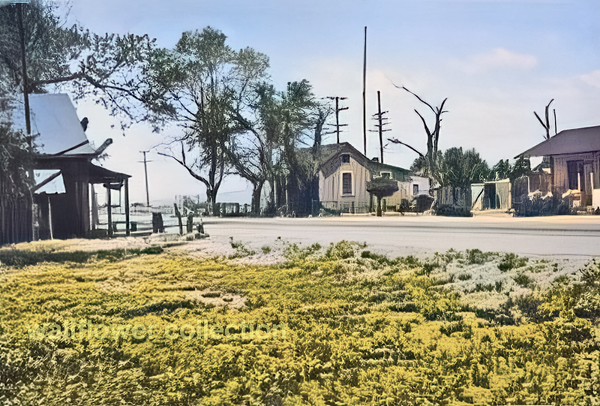
Yermo Road: That portion of old U.S. 91 that intersects with Alvord Road at Manix.
Reference - Mojave Desert Dictionary - P. Schoffstall, Mojave River Valley Museum
Peggy Sue's Diner
Del Taco
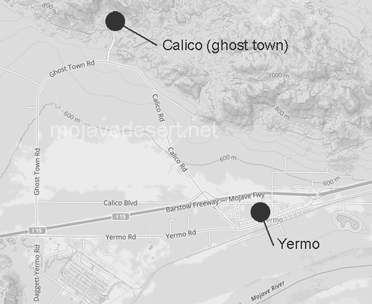
I-15 Freeway
Calico Ghost Town
Daggett
Mojave River
Yermo. Founded in 1902 as Otis, the name was later changed to Yermo, meaning "desert." it is the division point of the Union Pacific Railroad and is situated on Highway 91. Many of its citizens are employed in the US Marine Corps Supply Center close by. It is a natural stopover for tourist in as much as it is the "Gateway to the Calicos." Likewise, its rock shops are outstanding attractions.~ Heritage of the Mojave River Valley
About Yermo
Yermo is a small community in San Bernardino County, California, United States. It is located in the Mojave Desert, east of the city of Barstow, along Interstate 15. Despite its small size, Yermo is known for several points of interest and its historical significance to the region.One of the most notable attractions near Yermo is Calico Ghost Town, a former 1880s silver mining town that has been converted into a county park. Calico offers visitors a glimpse into California's mining history with restored buildings, museums, and the opportunity to explore mines. The town is also famous for its events and festivals, which often celebrate its Wild West heritage.
Yermo serves as a gateway to the Mojave National Preserve, a vast federal protected area that features natural beauty, with canyons, mountains, mesas, and desert vistas. It is a popular destination for hiking, camping, and sightseeing.
The community is also close to the Fort Irwin National Training Center, a major training area for the United States Military, which has contributed to the local economy and culture.
Despite its desert location and relatively small population, Yermo is a community with a rich history and serves as a stopover or base for exploring the natural beauty and historical sites of the Mojave Desert region.
History of Yermo, Ca.
Yermo, California, has a history intertwined with the development and exploration of the Mojave Desert, mining, and transportation routes. While detailed historical records specific to Yermo might not be as abundant as for larger cities, its story mirrors the broader narrative of the American West, especially during the 19th and 20th centuries.
Early History and Native Americans
Before European and American settlement, the area around Yermo was inhabited by Native American tribes who adapted to the desert environment. These indigenous people left behind petroglyphs and artifacts that suggest a rich cultural history and utilization of the diverse desert landscape.Mining Era
The discovery of silver in the late 19th century in places like Calico, located near Yermo, led to a mining boom. Prospectors and miners flocked to the region, leading to the establishment of several mining towns, including Calico, which became one of the most prolific silver mining areas in California during its peak. Although Yermo itself was not a mining town, it benefited from its proximity to these areas, serving as a supply and transit point.Railroads and Transportation
The development of railroads and major highways significantly impacted Yermo. The Atchison, Topeka and Santa Fe Railway and later, Route 66 and Interstate 15, facilitated the movement of goods and people through the Mojave Desert. Yermo's location along these transportation routes helped it become a stopping point for travelers and a logistical hub.Military Influence
The establishment of the Marine Corps Logistics Base Barstow and the Fort Irwin National Training Center nearby also contributed to Yermo's development. These military installations brought economic activity and a transient population of military personnel and their families to the area.Tourism and Preservation
In more recent history, the preservation of Calico as a historical site and the establishment of the Mojave National Preserve have made Yermo a gateway for tourists exploring these attractions. The conversion of Calico into a county park in the 1950s by Walter Knott (of Knott's Berry Farm fame) helped preserve an important part of California's mining history for future generations.Yermo today remains a small community, with its economy largely tied to tourism, the military, and the transportation industry. Its history reflects the broader trends of the American West, from the indigenous presence to the mining boom, transportation revolutions, and the modern emphasis on preservation and tourism.